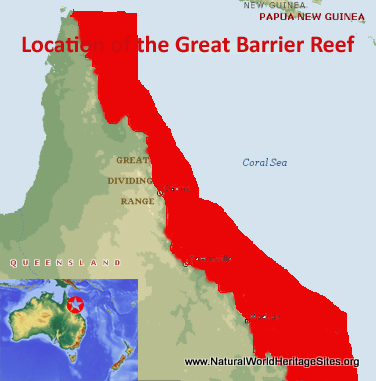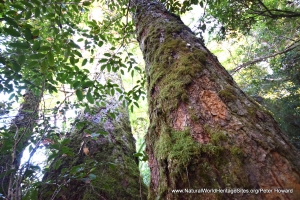EXPLORE the Great Barrier Reef with this slideshow, check the location map and get all the facts and information below.
For slideshow description see right or scroll down (mobile). Click to view slideshow
Location and Values: The Great Barrier Reef is located off the north-east coast of Australia and is the world’s most extensive coral reef system. Most of the reef lies within the world heritage area, making it by far the largest world heritage site globally – significantly larger than the whole of Italy (which, incidentally, had 54 world heritage sites within its 301,000 km2 area by 2018!). The Great Barrier Reef stretches for more than 2,000 km along the Queensland coast (corresponding with 14o of latitude), and includes some 2,500 individual reefs up to 250 km offshore. Biologically, the area is one of the richest and most complex ecosystems on earth, with a vast mosaic of reefs, islands and coral cays that have evolved over the millennia through four glacial-interglacial cycles. The structure and biological wealth of the present-day reef is the result of sea level changes that have periodically exposed, flooded and shaped the underwater world, which now supports an exceptionally rich marine fauna including a large number of endemic species. This is a place where exceptional natural phenomena occur, including the annual mass spawning of corals, migration of whales, communal nesting of turtles and seabirds, as well as spectacular aggregations of spawning fish.
Conservation Status and Threats. According to IUCN’s most recent Conservation Outlook Assessment (December 2020) the conservation status of the Great Barrier Reef is now considered ‘critical’, following a series of coral bleaching events in 2016, 2017 and 2020. The exceptional values which are recognized by the site’s inscription on the World Heritage List are now very seriously threatened by:
- Climate change. This is the single greatest threat to the site’s values, and the primary cause of recent bleaching events and death of corals over wide areas of the reef. Climate change has resulted in a decline in coral recruitment and reef building as well as observed declines in a range of other attributes including populations of loggerhead, hawksbill and northern green turtles, scalloped hammerhead sharks, seabirds and (possibly) some dolphin species.
- Catchment Water Run-off and Pollution. Forest clearance and poor agricultural practices in the mountain catchment areas of Queensland has resulted in excessive silt loads and pollution by agricultural effluents of the rivers that flow out along the coast next to the Great Barrier Reef. The degradation of waters from the catchment areas increases the turbidity of marine areas offshore and reduces the quality of the sea-water, affecting the survival and growth of corals in affected areas of the Great Barrier Reef.
- Coastal Infrastructure Development. Coastal infrastructure development including housing, roads, ports and mining activities is causing further run-off and pollution of the inshore waters, with sewage and other effluents that adversely affect the reef.
- Outbreaks of Crown-of-Thorns Starfish. This invasive species, which preys on many species of hard coral, can reach plague proportions and exacerbates the problems facing the Great Barrier Reef following bleaching events by further diminishing the viability of its corals.
- Over-fishing. Two thirds of the Great Barrier Reef is subject to commercial fishing, while a third is designated as no-take zones. Some species (such as scallop, snapper and pearl perch) are being over-fished, while gill-net fishing may result in the accidental capture of non-target species including those of conservation concern, such as dolphins, dugong, sawfish and sea snakes.
Links
Google Earth
IUCN Conservation Outlook
UNEP-WCMC Site Description
Official UNESCO Site Details
Slideshow description
The slideshow ‘tells the story’ of the Great Barrier Reef with a portfolio of photos by Peter Howard from a visit in January 2018. It starts with a series of photos taken during a typical shore-based excursion out of Cairns in a fast catamaran. There are a large number of such vessels offering trips onto the reef, enabling visitors to experience the area and its underwater world (without even getting into the water!). Of course, divers and snorkelers can see a great deal more than those who want to keep dry, but the experience of viewing the reef from a glass-bottomed boat or submarine can be enlightening. The photos show the coastal landscapes in this part of Queensland, where the forested hills of the Wet Tropics (world heritage site) meet the ocean, followed by images of Green Island, a coral cay that has been colonized by plants and animals and is now cloaked in a complex rainforest. The show then moves to the outer reef, where many tourist operators have established large floating platforms where food and drinks are served and visitors can view the underwater world from a glass-paneled submarine, snorkeling or diving. On the occasion of this trip, the sea was moderately rough and water clarity quite poor so the photos here show some of the colourful marine life as exhibited at the excellent aquariums in Townsville and Cairns. There are 1,500 species of fish, 400 corals, 4,000 molluscs and a wealth of other species on the Great Barrier Reef, and these photos give an idea of this diversity, illustrating species such as the orange-shouldered tang, moray eel, ray, anemone, clown fish, stone fish and lion fish, as well as corals, sea horse and mantid shrimp. The slideshow continues with some aerial views of the reef from a light aircraft, perhaps the best way to get an idea of the scale and complexity of the reef systems. The reef system around Green Island is shown as well as a tiny coral cay further north and the coastal strip between Port Douglas and Cairns. From the air, some of the coastal development – urban and agricultural – that threatens the ecological integrity of the Great Barrier Reef through pollution and sedimentation is clearly visible.
Factfile
Website Category: Marine & Coastal
Area: 348,700 km2
Inscribed: 1981
Criteria:
- Exceptional natural phenomenon (vii);
- Outstanding natural beauty (vii);
- Geological features (viii);
- Ecological processes (ix);
- Natural habitat for biodiversity (x);
- Significant number of rare, endemic and/or endangered species (x)





